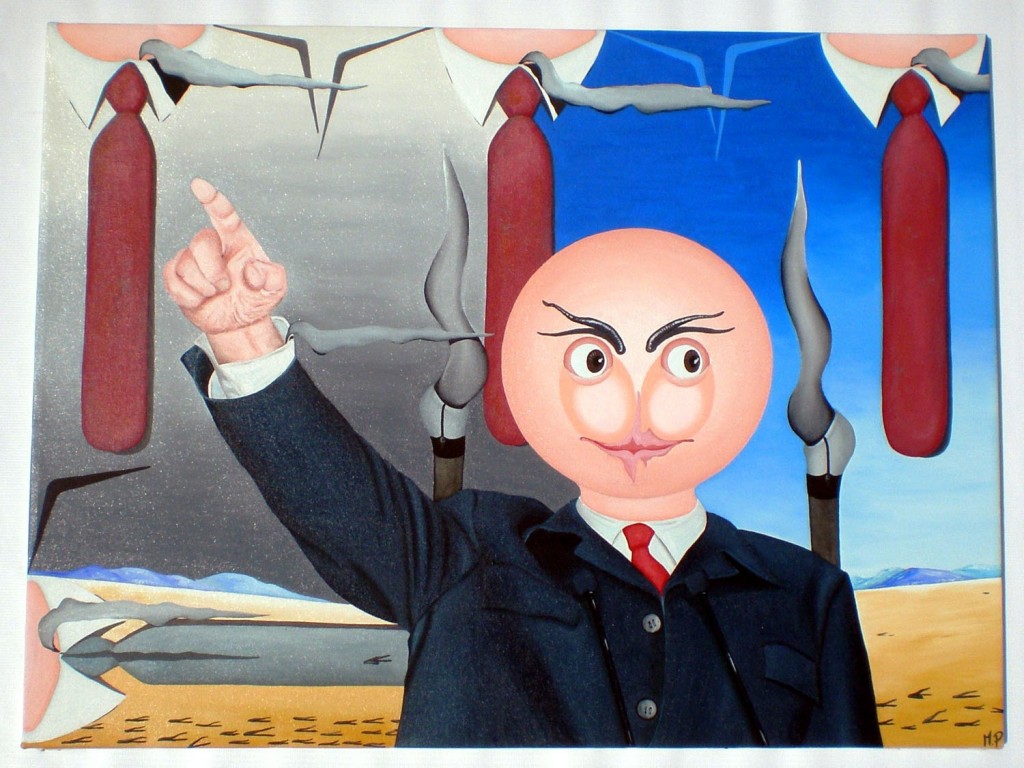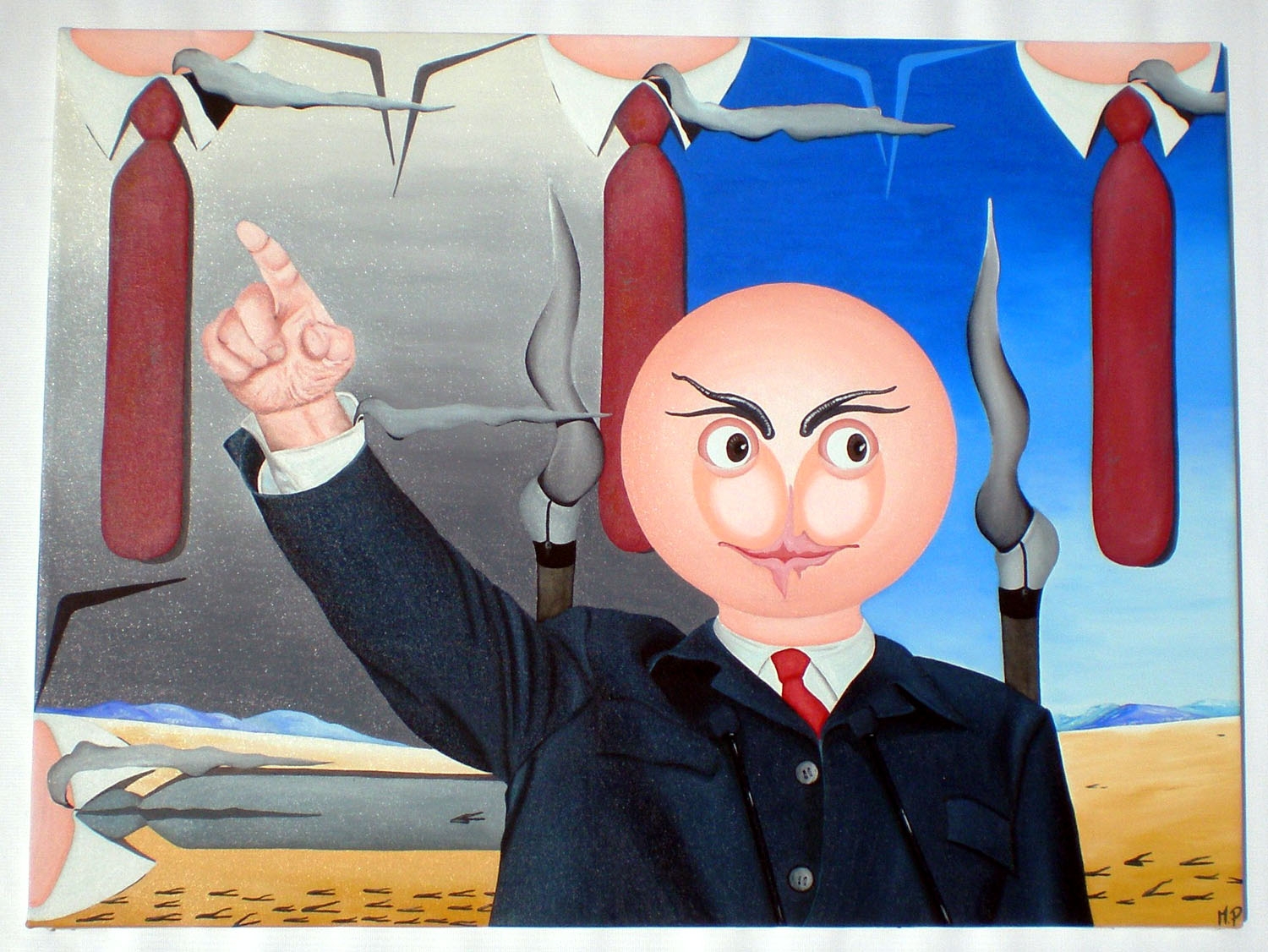
Il quadro, diviso a metà dalla cravatta rossiccia dell’uomo senza volto al centro dello sfondo, mette in risalto due differenti realtà, due frammenti di mondo in dicotomia tra loro.
L’atmosfera terrificante, agghiacciante, è data da una stesura senza “impronte” del colore. Un colore espressivo nella tonalità ma non nella gestualità del segno.
L’iconografia del dipinto rende con attributi “contemporanei” l’Autocrate che con argomenti illusionistici e alchemici esalta la massa per poi piegarla al proprio volere e a quello dei suoi consiglieri occulti. Un conoscitore di retorica e di populismo che conforma a sua immagine la moltitudine. Il quadro richiama alla memoria “una storia” oramai dimenticata, depauperata della sua natura educativa. Il braccio alzato con l’indice rivolto in alto, ad indicare gli avversari, diventa ad un tratto una condanna nei confronti di chi vuole opporsi contrastandone la propaggine corruttiva ed invece dovrebbe ammonire affaristi e speculatori che con scelte politico-economiche “scientifiche” stravolgono l’esistenza di milioni di persone costringendoli ad una vita di miseria e di migrazione forzata.
L’artista riprende da una fotografia l’immagine del premio nobel Aleksandr Solgenitsyn, autore di “Arcipelago Gulag”, e la trasforma in una icona contemporanea alterandone volutamente la portata morale. Contestualizzata in una nuova realtà, desertica e coreografata da uomini senza volto, richiama la ritrattistica “dittatoriale” che imbratta le città a fini propagandistici. Un riferimento studiato dall’autore per evidenziare come il “bene” e il “male” veicolino le proprie idee usando gli stessi mezzi comunicativi, la stessa gestualità, la stessa posa e lo stesso vestire.
Fall of ideologies
The painting, of a historical nature, is the middle man in a suit and tie while haranguing the audience microphones. The gaze of the subject, facing the left side of the canvas, it invites the viewer to penetrate the space of painting and scroll through the eyes, like a written text, the elements of pictorial composition. A politician or ideologue ready to assemble, incinerated and fetid with conspiracy concepts, a new ideology: “the dialectical vacuity”. Behind sprout two chimneys in the shape of female legs, similar to cypress trees, emblems of death, which frame the spherical head. In the background, arranged choreography, the “white collar” faceless businessmen, merchants of souls, delegates administrators of people’s lives, counselors of hidden puppet guy. Miasma ashen, undulating and meandering in their development, they rise by the lapels and sleeves mild man, meanwhile, an army of leeches forward in search of new nations and new human resources, economic, energy, pins and drain.
The painting, divided in half by reddish tie faceless man in the center background, highlights two different realities, two fragments of world dichotomy between them.
The atmosphere terrifying, chilling, is given by a drawing without the “fingerprints” of color. An expressive color in the shade but not in the gestures of the sign.
The iconography of the painting with attributes makes “contemporary” with arguments that the Autocrat illusionist and alchemic enhances the mass and then bend to his will and that of his advisers occult. A connoisseur of rhetoric and populism in his image that conforms to the multitude. The picture is reminiscent of a “history” now forgotten, depleted of its educational nature. The raised arm with the index turned upward, indicating opponents, suddenly becomes a condemnation of those who want to oppose and counter the offshoot corrupt businessmen and speculators but should warn that political and economic choices with “scientific” distort the ‘existence of millions of people forcing them to a life of poverty and forced migration.
The artist takes a photograph image of Nobel laureate Alexander Solgenitsyn, author of “The Gulag Archipelago” and transforms it into a contemporary icon deliberately altering the scope of morality. Contextualized in a new reality, desert and choreographed by faceless men, recalls the portraits “dictatorial” that soils the city for propaganda purposes. A reference designed to highlight the author as “good” and “evil” convey their ideas using the same means of communication, the same gestures, the same pose and the same dress.
In collezione privata
